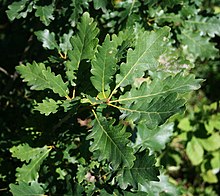Quercus iberica
| Quercus iberica | |
|---|---|

| |
| Foliage | |
| Scientific classification | |
| Kingdom: | Plantae |
| Clade: | Tracheophytes |
| Clade: | Angiosperms |
| Clade: | Eudicots |
| Clade: | Rosids |
| Order: | Fagales |
| Family: | Fagaceae |
| Genus: | Quercus |
| Subgenus: | Quercus subg. Quercus |
| Section: | Quercus sect. Quercus |
| Species: | Q. iberica
|
| Binomial name | |
| Quercus iberica | |
Quercus iberica, the Georgian oak, is a deciduous tree native to the Caucasus (including regions of coastal northeastern Turkey, Asia Minor and Iran).[1] The Georgian oak is a fairly large tree growing up to 20–25 metres (66–82 ft) in height, or exceptionally up to 40 m (130 ft). Q. iberica is known for its very short stalk and acorns that occur either in pairs or alone.[1] The tree is widely distributed throughout the drier regions of Eastern Georgia and generally does not like excessively moist or marshy soils, although it can be found in large groves in moist areas of Western Georgia as well. Q. iberica forms forests together with chestnut, hornbeam and maple. In most areas, the Georgian oak grows at elevations of 400–1,000 m (1,300–3,300 ft) above sea level, but in some cases it can be found at elevations up to 1,500–2,000 m (4,900–6,600 ft) above sea level.[1] It is sometimes treated as a subspecies of Quercus petraea.[2]
References[]
- ^ a b c Georgian State (Soviet) Encyclopedia. 1986. Book 10. p. 483.
- ^ "Quercus iberica". Germplasm Resources Information Network (GRIN). Agricultural Research Service (ARS), United States Department of Agriculture (USDA). Retrieved February 14, 2011.
- Quercus
- Flora of Europe
- Plants described in 1808
- Quercus stubs